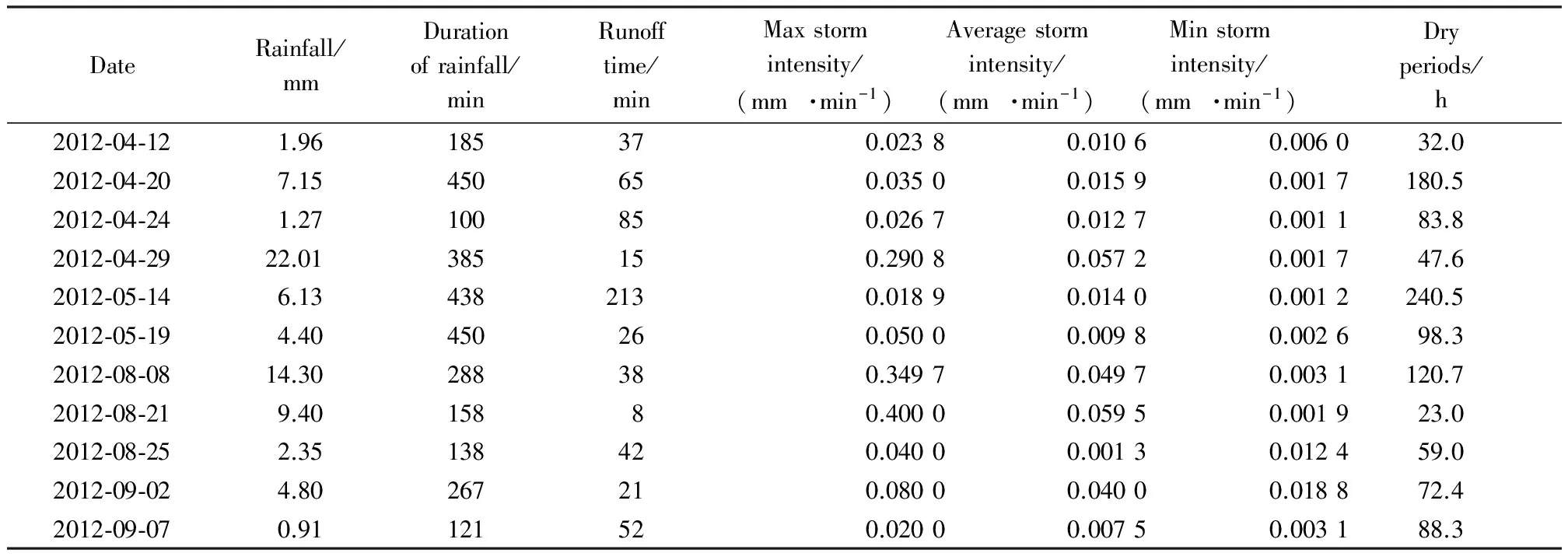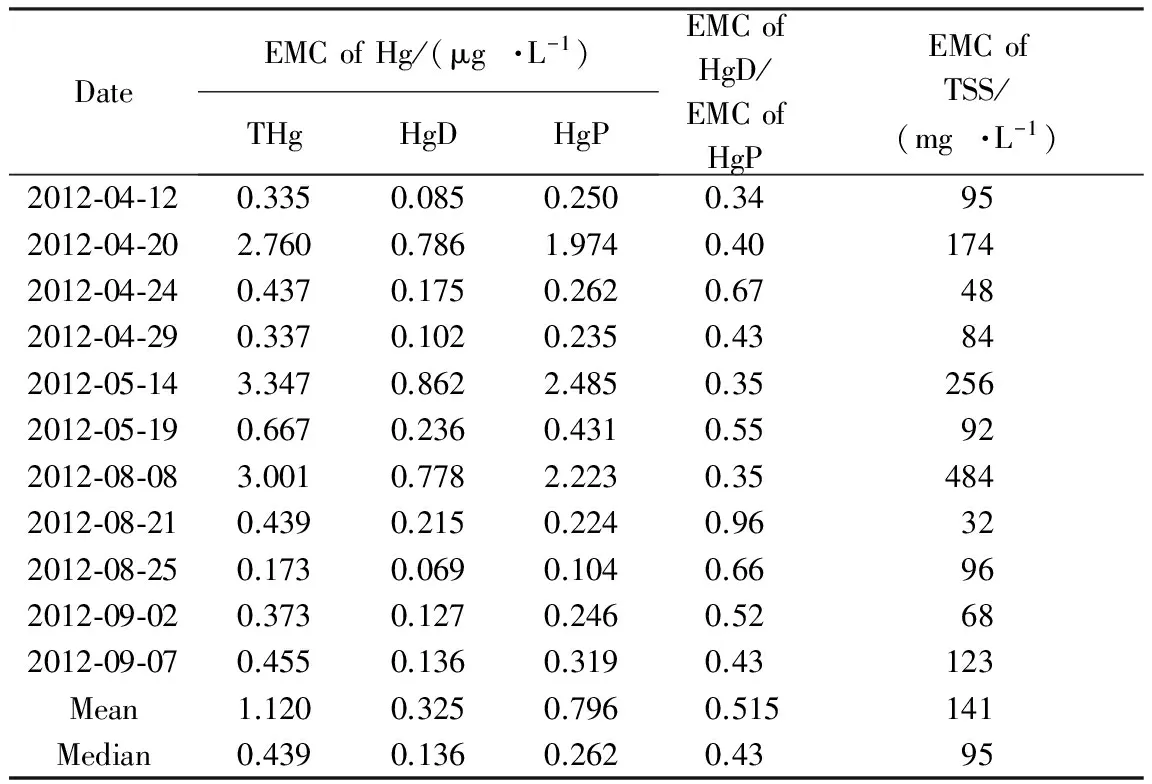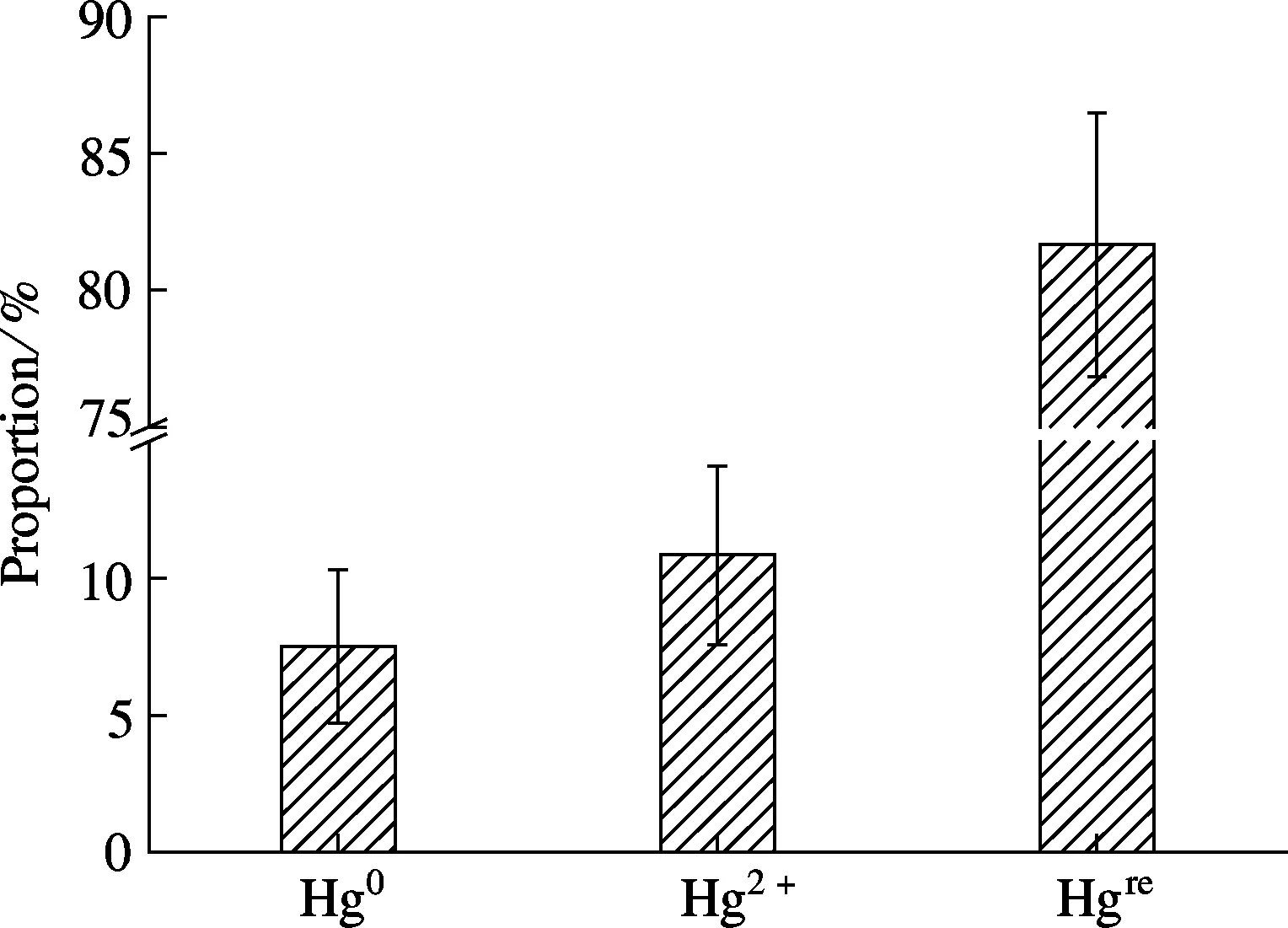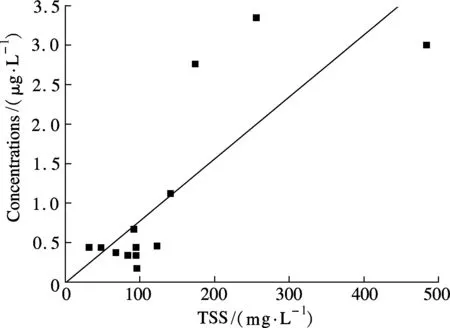Characteristics of Hg pollution in urban stormwater runoff in Nanjing city, China
2014-09-06ChenMingZhengZhaohuiFuDafangZhangKefeng
Chen Ming Zheng Zhaohui Fu Dafang Zhang Kefeng
(1School of Civil Engineering, Southeast University, Nanjing 210096, China)(2Department of Civil Engineering, Monash University, Melbourne, VIC 3800, Australia)
Characteristics of Hg pollution in urban stormwater runoff in Nanjing city, China
Chen Ming1Zheng Zhaohui1Fu Dafang1Zhang Kefeng2
(1School of Civil Engineering, Southeast University, Nanjing 210096, China)(2Department of Civil Engineering, Monash University, Melbourne, VIC 3800, Australia)
In order to assess the mercury (Hg) pollution in urban stormwater runoff in Nanjing, 11 rainfall events in the Maqun region of Nanjing circle expressway were monitored, and the events mean concentrations (EMC) of Hg and the impact of rainfall characteristics on Hg pollution in runoff were analyzed. Results show that the pollution of different Hg species is serious, and total Hg (THg), dissolved Hg (HgD) and particulate Hg (HgP) are found to be in the range of 0.173 to 3.347, 0.069 to 0.862, and 0.104 to 2.485 μg/L, respectively. The average EMC value of THg exceeds the Ⅴ class limitation value of “Quality standards of surface water environment (GB 3838—2002)” of China. Hg in runoff mainly exists in particulate form, and the concentrations of Hgre(0.250 to 2.821 μg/L) are far more than those of Hg0(0.023 to 0.215 μg/L) and Hg2+(0.026 to 0.359 μg/L). The order of rainfall characteristics impacting on Hg pollution in runoff is dry periods> runoff time> duration of rainfall> storm intensity> rainfall.
Hg pollution; urban runoff; events mean concentrations (EMC); impact factor
Along with the rapid development of urbanization and modernization, polluted runoff has become one of the major causes of water quality impairment in urban area. In recent decades, some countries or regions have conducted related investigations of contaminants in road runoff[1-3]. However, most of the previous studies mainly focused on suspended solid, nutrients[4-5]and heavy metals such as Cu, Zn, Pb and Cr[3], and the ignorance of Mercury (Hg) leads to very few surveys about its pollution in urban runoff[6]. Hg contamination of the aquatic environment has aroused more and more researchers’ concern, due to its strong toxicity at very low concentrations, wide distribution and diversity of sources[7]. Some studies have found that rivers flowing through urban areas have higher Hg concentrations compared with rural areas[8-9], probably caused by pollution of urban runoff. Hg in urban runoff mainly comes from atmospheric deposition, vehicle sources, and the road surface wear, which might accumulate in aquatic organisms, and affect human health through the food chain. Hg in the environment exists in different forms (particulate Hg and dissolved Hg) as well as in different valence states[6,10], which might be determined by various factors such as materials in road construction, land using types, transport and human activities. The hazards of various Hg species are different, and therefore, the revealing of different Hg species in road runoff is significant to assess the pollution level of runoff and to determine the treatment process of Hg pollution.
The road runoff from the Maqun region of Nanjing circle expressway was selected as object and 11 rainfall events were monitored from April to September in 2012. Events mean concentrations (EMC) of different Hg species were detected and the impact factors of Hg pollution in the runoff of expressway were analyzed. The objective of this study is to assess Hg pollution levels in road runoff in urban area, and also, to provide basic data and theoretical support for the treatment of Hg pollution and the reuse of stormwater.
1 Methods
1.1 Site description
Nanjing is located in the middle and lower reaches of the Yangtze River region in eastern of China (see Fig.1), with the average temperature of 15.3 ℃. The annual average rainfall in Nanjing is 1 106.05 mm, with most of the rainfalls occurring in summer time. The Maqun region of Nanjing circle expressway is one of the main ways of entering the city center, situated at the east of Nanjing (see Fig.1). The road runoffs from the Maqun region are collected via PVC pipe for Hg monitoring. The area of catchment is 1 100 m2, with road material of pitch. The vehicle flow rate is 38 400 veh/d and the nearby land use types include residency, transport, and industry.
1.2 Rainfall properties and sample collection
Eleven effective rainfall events were monitored from April to September in 2012, and the properties of these rainfalls are given in Tab.1.
To reveal the pollution levels of Hg comprehensively, every whole rainfall event was monitored by artificial sampling. In the first 30 min of the runoff formation, samples were collected at 5 to 10 min intervals by using 1 L polyethylene bottles; samples were collected at 10 to 15 min intervals during 30 to 60 min; after that, samples were collected at 30 to 60 min intervals to the end of the rainfall event. JS22 Siphon-hyetometer (Tianjin meteorological instrument industry) was applied to record the properties of the rainfall including volume and intensity of rain, within the catchment 500 m apart and 1.5 m above the surface (see Fig.1).
1.3 Hg analysis
Once collected, samples were sent to the laboratory and analyzed in 24 h. Total suspended solids (TSS), total Hg (THg), dissolved Hg (HgD), particulate Hg (HgP), volatile Hg (Hg0), active Hg (Hg2+), and inactive Hg (Hgre) were analyzed.
The samples were pretreated by adding HCl to adjust the pH to less than 1 and then 0.5 g K2CrO4to keep the orange color of the water, followed by shaking up. Pretreated samples were kept in the temperature range of 0 to 4 ℃ to minimize the loss of Hg. HgT and HgD were determined by Hydra Ⅱ A mercury vapourmeter, while Hg at various valence states was detected by HydraⅡ C mercury vapourmeter. Analysis methods are shown in Tab.2.

Tab.1 Summary of the properties of rainfalls

Tab.2 Analysis methods of different Hg species
1.4 Events mean concentrations (EMC)
The concentrations of contaminants vary greatly during the whole rainfall process. Therefore, EMC was adopted to assess the pollution levels in road runoff, which was represented by the ratio of total pollution loads and total volume of runoff (USEPA)[11]. The formulation of EMC is
whereMis the total mass of the contaminant;Vis the total volume of runoff;C(t) is the concentration of the contaminant at different times;Q(t) is the flow of runoff;tis the runoff time.
This study does not monitor the volume of runoff due to the limitation of equipment, but records the beginning of rainfall and the formation time of runoff, and eliminates the hysteresis of runoff and the duration of rainfalls to guarantee the synchronicity of them. In addition, the evaporation and infiltration of runoff during the rainfall are limited, which can be ignored. Therefore, rainfalls could be used to alternate the total volume of runoff to calculate EMC.
2 Results and Discussion
2.1 EMC of Hg pollutions and their occurrence forms
Tab.3 presents EMC of Hg in stormwater runoff events. As it can be seen, the concentrations of Hg in different occurrence forms varied greatly over 11 rainfall events, ranging from 0.173 μg/L to 3.347 μg/L for THg, from 0.069 to 0.862 μg/L for HgD, and from 0.104 to 2.485 μg/L for HgP, respectively. The EMC of THg on 20th April, 14th May, 8th August and also the average value of all rainfall events far exceeded 1.0 μg/L, which is the Ⅴ class limitation value of “Quality standards of surface water environment (GB 3838—2002)” of China. It is hypothesized that dry periods had a significant influence on Hg pollution due to the relatively long time before these rainfall events. While the EMC of the other events also exceeded the Ⅲ class limitation value (0.1 μg/L). The high concentrations of Hg in runoff, therefore, would cause severe pollution once entering water bodies.

Tab.3 EMC of Hg pollution in runoff
Tab.4 shows relevant studies done by other researchers around the world. It is clear that Hg pollution in runoff is more serious in China. Furthermore, the pollution of Hg in Nanjing is also worse than that in Beijing and Shanghai, but comparable to Tianjin. Hg mainly comes from the discharge of automobile, the wear degree of the road materials, and some other human activities. It is hypothesized that land uses, weather conditions, and traffic caused the differences.

Tab.4 EMC of Hg pollution in different regions (average value)
The average EMC of HgP was 0.796 μg/L, which was around 3.4 times that of HgD. The forms of Hg can be reflected by the proportion of HgP and HgD. HgD/HgP of runoff in the 11 rainfalls were all less than 1 (see Tab.3), illustrating that Hg concentrations were in a predominantly particulate bound form. Eckley and Branfireun[6]reported a similar result that particulate Hg accounted for 84% of total Hg. HgD can be easily absorbed by aquatic organisms, followed by accumulating in the human body through the food chain; while HgP would be adsorbed on sediments for a long time, and transfer to HgD in suitable conditions. Therefore, the partial removal of Hg might be achieved by precipitation.
2.2 EMC of Hg in different valence states
The hazards of Hg in various valence states are different, and, therefore, the revealing of different Hg species in road runoff is significant to assess the pollution level. The concentrations of Hg in different valence states (Hg0, Hg2+, and Hgre) in runoff were monitored for six rainfall events, and the results are given in Fig.2.

Fig.2 EMC of Hg in different valence states in runoff
As it can be seen from Fig.2, the concentrations of EMC of Hg0, Hg2+, and Hgrechanged greatly, with 0.023 to 0.215, 0.026 to 0.359, and 0.250 to 2.821 μg/L, respectively. The average concentration of Hgrewas 1.080 μg/L, which was much higher than that of Hg0(0.090 μg/L) and Hg2+(0.150 μg/L). Wang et al.[10]investigated the EMC of Hg in different species in a farmland near Beijing and found that the EMC of Hg0, Hg2+and Hgrewere 0.011, 0.0429 and 0.0536 μg/L, respectively, which were all lower than the results of this study, indicating that Hg pollution of road runoff was much more serious, and also demonstrating different occurrence regularity in different regions.
Fig.3 shows the proportions of different Hg species. The average percentage of Hgreis 81.66%, which is more than 10 times that of Hg0(7.51%). Fortunately, Hgreis relatively stable and less hazardous compared to Hg0. The proportion of Hg2+is 10.85%. However, compared to Hgreand Hg0, Hg2+is relatively activated. Hg2+can easily transfer to methyl mercury, which has higher toxicity.
According to the investigation results of Liu et al.[14]in some places with different land use types in Beijing, the concentrations of Hgre(0.171 μg/L) were much more than those of Hg0(0.039 μg/L) and Hg2+(0.066 μg/L), which was similar to this study. Zhang et al.[12]reported that the concentration of Hgrewas at the same level as Hg2+,both of which were about 4 to 5 times that of Hg0in Beijing[12]. It is assumed that the species of Hg in runoff is related to the sources of Hg in the environment, which in turn leads to the differences of Hg species in water. Therefore, the investigation of the sources of Hg is significant to control Hg pollution.

Fig.3 Proportion of Hg in different valence states
2.3 Analysis of the relationship between EMC of Hg and TSS
Tab.5 provides data of Pearson correlation coefficients of different Hg species and TSS. Different Hg species were all positively correlated with TSS in 0.01 levels except Hg0(but correlated in 0.05 levels) in this study, with the Pearson correlation coefficients ranging from 0.768 to 0.954. For Hg in different occurrence forms in runoff, the Pearson correlation coefficient of HgP was the highest, indicating that Hg mainly existed as particulate form. There was a significant TSS/THg relationship (r2=0.67,p<0.01) in the study in Toronto near Lake Ontario[6], which was similar to this study (r2=0.657, Fig.4(a)). For Hg in various valence states, the Pearson correlation coefficient of Hgrewas the highest. Furthermore, the concentrations of Hgreand TSS satisfied linear correlation (r2=0.910 5, Fig.4(b)), indicating that most of Hgreadsorbed on particles in road runoff.
Tab.5 Pearson correlation coefficients of different Hg species and TSS

HgTSSTHg∗∗0.807HgD∗∗0.768HgP∗∗0.819Hg0∗0.850Hg2+∗∗0.923Hgre∗∗0.954
Notes:**correlated in 0.01 levels;*correlated in 0.05 levels.
2.4 Influence of rainfall characteristics
Cluster analysis was adopted to study the relationship between EMC of Hg and different characteristics of rainfalls. The impact levels were represented by the length between different variables in the tree diagram of cluster analysis, which was depicted by Minitab 15. Shorter length indicates higher relativity, which was taken to assess the influence levels of characteristics of rainfall to Hg pollution in road runoff.
This study took the Maqun region of Nanjing city expressway as research site, and some impact factors including road materials, lands use types, vehicle flow rate, atmospheric sedimentation, and the methods of road cleaning were relatively stable. Dry periods(sunny days), runoff time, duration of rainfall, rainfall intensity, and rainfall were considered as main influence factors. The cluster analysis of these factors and Hg in different occurrences is shown in Fig.5. The influence factors of rainfall characteristics on different Hg species are the same. It is then apparent that the length between dry 3 periods and Hg is shortest, no matter which form of Hg exists, indicating that Hg pollution in road runoff mainly comes from the accumulation of particle contaminants in dry periods, which leads to the pollution level of Hg in runoff. It is reported that pollutants accumulate on urban surfaces mainly from dry atmospheric deposition as well as from vehicle sources during dry periods[15]. For all of these impact factors, the order is dry periods> runoff time> duration of rainfall> storm intensity> rainfall.

(a) THg

(b) Hgre

Fig.5 Cluster analysis of different Hg species and characteristics of rainfalls
3 Conclusions
The ranges of Hg in different occurrence forms in runoff vary greatly, ranging from 0.173 to 3.347 μg/L for THg, 0.069 to 0.862 μg/L for HgD, and 0.104 to 2.485 μg/L for HgP. The average value is 1.120 μg/L, exceeding the V class limitation value of “Quality standards of surface water environment (GB3838—2002)” of China. The ranges of EMC of Hg in different valence states are 0.023 to 0.215 μg/L for Hg0, 0.026 to 0.359 μg/L for Hg2+, and 0.250 to 2.821 μg/L for Hgre. The concentrations of Hgreare far more than that of Hg0and Hg2+. Different Hg species in runoff are positively correlated with TSS, indicating that Hg mainly existed as particle type, and most of the Hg can be removed by precipitation. The order of impact factors on Hg pollution is dry periods> runoff time> duration of rainfall> storm intensity> rainfall.
[1]Sansalone J J, Buchberger S G. Partitioning and first flush of metals in urban roadway storm water [J].JournalofEnvironmentalEngineering, 1997, 123(2):134-143.
[2]Sörme L, Lagerkvist R. Sources of heavy metals in urban wastewater in Stockholm [J].ScienceoftheTotalEnvironment, 2002, 298(1/2/3): 131-145.
[3]Li H, Shi J, Shen G, et al. Characteristics of metals pollution in expressway stormwater runoff [J].EnvironmentalScience, 2009, 30(6):1621-1625. (in Chinese)
[4]Chebbo G, Gromaire M C. The experimental urban catchment ‘Le Marais’ in Paris: What lessons can be learned from it? [J].JournalofHydrology, 2004, 299(3/4): 312-323.
[5]Hook A M, Yeakley J A. Stormflow dynamics of dissolved organic carbon and total dissolved nitrogen in a small urban watershed [J].Biogeochemistry, 2005, 75(3): 409-431.
[6]Eckley C S, Branfireun B. Mercury mobilization in urban stormwater runoff [J].ScienceoftheTotalEnvironment, 2008, 403(1/2/3): 164-177.
[7]Ratcliffe H E, Swanson G M, Fischer L J. Human exposure to mercury: a critical assessment of the evidence of adverse health effects [J].JournalofToxicologyandEnvironmentalHealth, 1996, 49(3): 221-270.
[8]Mason R P, Sullivan K A. Mercury and methylmercury transport through an urban watershed [J].WaterResearch, 1998, 32(2):321-30.
[9]Lawson N M, Mason R P, Laporte J M. The fate and transport of mercury, methylmercury, and other trace metals in Chesapeake Bay tributaries [J].WaterResearch, 2001, 35(2):501-515.
[10]Wang W, Liu J, Peng A. Mercury origin in surface runoff caused by precipitation [J].Agro-EnvironmentalProtection, 2001, 20(5): 297-301. (in Chinese)
[11]USEPA. Results of the nationwide urban runoff program[R]. Washington, DC: US Environmental Protection Agency, 1993.
[12]Zhang J J, Bi C J, Chen Z L, et al. Assessment on the effect of surface dust on mercury and arsenic in rainfall-runoff in the Shanghai urban district [J].JournalofEastChinaNormalUniversity:NaturalScience, 2011(1):195-202. (in Chinese)
[13]Li Q, Li T, Zhao Q, et al. Characteristics of heavy metal pollution in road rainfall-runoff of Tianjin city [J].EcologyandEnvironmentalSciences, 2011, 20(1):143-148. (in Chinese)
[14]Liu J, Wang W, Peng A. Mercury species in precipitation [J].ChineseJournalofEnvironmentalScience, 2000, 21(5):43-47. (in Chinese)
[15]Charlesworth S, Everett M, McCarthy R, et al. A comparative study of heavy metal concentration and distribution in deposited street dusts in a large and a small urban area: Birmingham and Coventry, West Midlands, UK [J].EnvironmentInternational, 2003, 29(5): 563-573.
南京市路面雨水径流汞Hg污染特性研究
陈 明1郑兆辉1傅大放1张科峰2
(1东南大学土木工程学院,南京 210096) (2莫纳什大学土木工程系,澳大利亚墨尔本 VIC 3800)
为评估降雨路面径流汞(Hg)污染状况,对南京绕城高速公路马群段11场降雨路面径流进行了监测,分析了汞(Hg)的事件平均浓度(EMC)以及降雨特性对径流中Hg污染的影响.结果表明,不同赋存状态的Hg的污染程度均较为严重,总Hg(THg)、溶解态汞(HgD)和颗粒态汞(HgP)含量分别为0.173~ 3.347,0.069~0.862和0.104~2.485 μg/L.THg的EMC超过了中国《地表水环境质量标准(GB 3838—2002)》中5类水的限值.雨水径流中Hg主要以颗粒态存在,络合态Hg(Hgre,0.250~2.821 μg/L)的含量远大于挥发性Hg(Hg0,0.023~0.215μg/L)和活性Hg(Hg2+,0.026~0.359 μg/L).各种降雨特性对径流中Hg污染的影响顺序为前期晴天数>径流时间>降雨历时>降雨强度>降雨量.
汞污染;城市径流;事件平均浓度(EMC);影响因素
X508
The Priority Academic Program Development of Jiangsu Higher Education Institutions.
:Chen Ming, Zheng Zhaohui, Fu Dafang, et al.Characteristics of Hg pollution in urban stormwater runoff in Nanjing city, China[J].Journal of Southeast University (English Edition),2014,30(2):158-163.
10.3969/j.issn.1003-7985.2014.02.004
10.3969/j.issn.1003-7985.2014.02.004
Received 2013-10-11.
Biographies:Chen Ming (1986—), male, graduate; Fu Dafang (corresponding author), male, doctor, professor, fdf@seu.edu.cn.
猜你喜欢
杂志排行
Journal of Southeast University(English Edition)的其它文章
- Prediction on effectiveness of road sweepingfor highway runoff pollution control
- A preliminary sustainability assessment of innovativerainwater harvesting for residential properties in the UK
- Approach to estimating non-point pollutant load removal rates based on water environmental capacity: a case study in Shenzhen
- Potential contributions to Beijing’s water supply from reuse of storm- and greywater
- Rainwater harvesting in the challenge of droughts and climate change in semi-arid Brazil
- Practice and analysis of recycling non-drinking waterfrom air-condition and reverse-osmosis systeminto rainwater collection system
